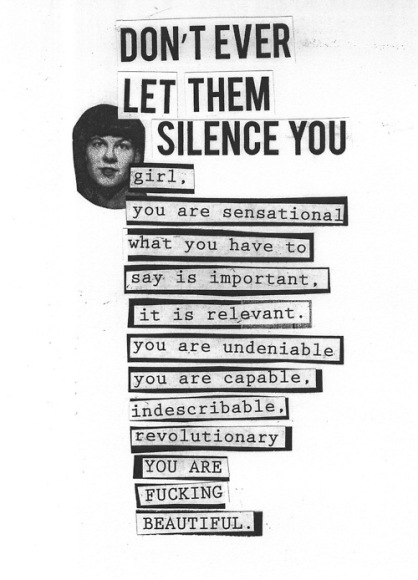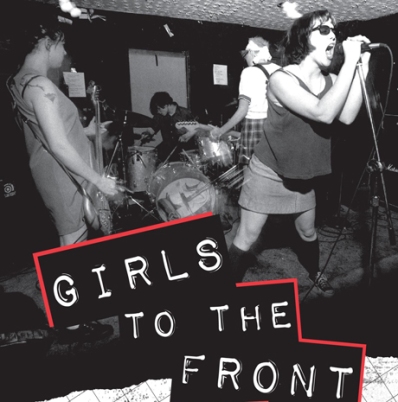As we have written in our recent blog posts, audience interaction is an integral part of the Riot Grrrl movement and genre within the context of musical performances and off-stage interactions. Just as Riot Grrrl entails a community focused on production, a set of ideals, and a means of transmission, the exchange between artist and community is another key facet of this genre. This post will explore the importance and role between musician and audience in defining Riot Grrrl through DIY Zines, social inclusion, and involvement from both artist and audience.

Retrieved from http://www.worldaccordingtomaggie.com/photographyylms/bikini-kill-poster
To preface, the dichotomy that usually exists between performers and consumers of music is rendered almost non-existent within this genre. The term ‘audience’ becomes potentially problematic when applied to Riot Grrrl music culture. So, the term ‘audience’ will be used lightly. The normal juxtaposition of the performer as a figure that is to be looked at and the audience as people who “look” cannot always be applied to this genre. We view this genre as an exchange of power that is egalitarian between performer and audience member. Performers and audiences move fluidly between roles, and their gaze is never focused on one another, but at common goals and aesthetic values. Elke Zobl describes in her article, Revolution Grrrl and Lady Style, Now! that the encouragement of audience members to actively participate along with the artist “merged the distinctive (and hierarchical) roles between audience and performer” (Zobl, 446) and in the process has helped create participatory culture among Riot Grrrls and the musician.

Retrieved from http://v1.dyingdays.net/Bikini_Kill/index.html
DIY Culture
Participants in the Riot Grrrl movement have been seen as the “third wave” of feminism, resisting male dominated punk hegemony by creating a supportive environment for female interaction. Zines such as Girl Germs and Chainsaw, helped establish the culture of both the community and the bands influencing cooperatively the message of what Riot Grrrl would become. These zines have created an atmosphere for young women to address issues like anorexia, body image, rape, sexism, and racism. Since the early 1990s these ideas dispersed internationally through “Revolution Grrrl and Lady Style, Now!” Zines were largely self-published self-distributed magazines made for young women and queer youth creating an informal network of friendships within the Riot Grrrl scene. This movement relied on an “expansive and shifting networks of clubs, labels, record stores, zines, and zine distributors (“distros”)” (Zobl, 446). Zine writing and publishing became a method of empowerment by subverting standard patriarchal mainstream media without being censored.

Retrieved from https://ablazing.wordpress.com/tag/riot-grrrl/
Through this feminist network, listeners were able to take and assert themselves as cultural activists for their own gender. The creation of art became a revolutionary act to counter the mainstream. Bands like Bikini Kill, Bratmobile, and Heavens to Betsy helped offer a gateway into the subculture that is Riot Grrrl. Instead of accepting mainstream representations of the female body, and removing themselves from popular (corporate) culture, young women, feminists, and band members have used these tools of cultural production for themselves. Listeners and audience members have assumed the role of do-it-yourself-ers (DIY) creating their own personal symbols, style, cultural system, and images of self-representation in which to show their own political resistance. Zobl states in her article, “They simply do not want to be part of the establishment and mainstream culture; instead they want to provide an alternative to the dominant culture“ (Zobl, 445).
As we have noted, Riot Grrrls have created a deep-rooted punk feminist community and helped evoke young women and girls’ sub cultural resistance through an exploration of radical political individuality. Examples like Bikini Kill have declared a “Revolution Girl-Style” in their manifesto:
“They called upon young women to form bands, to mutually learn and teach the playing of instruments, and to publish zines.” (Zobl, 446).
This radical cultural resistance and alternative to the dominant culture is a way for these women to assert themselves among a male oriented music culture. By publishing zines, the community was offered a way of collective empowerment by voicing their opinions against, sexism, and gender based discrimination. By encouraging audience members to actively participate during shows and through their acts of DIY culture. Through the genre, a message of revolution was created, “for young women: namely, self-empowerment through the method of DIY” (Zobl, 446). By doing these actions, many Riot Grrrls liberated themselves from restrictive (male) notions of control by empowering one another through these DIY methods.
‘Grrrl Love” and audience participation
Riot Grrrls recognized young women who have been conditioned to be competitive, envious, and resentful of one another. Communities within the movement decided to remedy this damaging social construct and female on female bullying by creating and advocating for “grrrl love.” Allowing for a space where women should be supportive and encourage their fellow grrrl. Bikini Kill’s Riot Grrrl anthem “Rebel Girl” entails this ‘grrrl love’ transforming the genre and the audience through acts of inclusion and camaraderie.
Take a listen here, Rebel Girl by Bikini Kill
This “Rebel Girl” anthem teaches grrrls to stand up for each other in the face of rumor and gossip. For example in the lyrics, “They say she’s a slut but I know/she is my best friend” shows the way in which women can deflect gossip and remain in solidarity. As well, “That girl she holds her head up so high/I think I wanna be her best friend” offers a way in which womanhood exudes a state of confidence and high self-esteem.
Lead singer of Bikini Kill, Kathleen Hanna is a prime example of exuding confident womanhood in the face of opposition. In this clip, you will see her address the crowd and bring the girls to the front. Specifically from times 0:40-1:04.
The Punk Singer- Bikini Kill, Girls to the Front
The way in which Hanna uses her body to subvert ideals of the female body, and pushes for the females to stand at the front (with loud cheering from the crowd) shows the way in which the community and the singer are actually purposefully connected, breaking the barrier between performer and the crowd. This pushing of boundaries between performer and crowd become intertwined with one another to create a live experience that incorporates everyone involved. The hierarchy of artist/performer over the audience is removed through the connection and merging of audience and performer participation. The advocating for girls to come to the front and the “boys to chill out for once” is a way in which Hanna has attempted to gain control of the space where women are supported within the room of the club.

Retrieved from https://tropicsofmeta.wordpress.com/2012/05/02/when-she-talks-i-hear-the-revolution-looking-back-at-the-riot-grrrl-revolt/
In the name of “grrrl love,” Riot Grrrl artists have encouraged young women to entwine feminist art, activism, music, and politics. Notoriously Bikini Kill is known for stopping in the middle of their shows to confront violence or sexist comments from the male audience. Hanna shared in an interview,
“At a show, as the person with the microphone I feel like I have a certain responsibility, because I can communicate to everybody in the room. So if I see a woman being fucked with, I might say, ‘You—outta here now!’ and make the community accountable for removing that person.” (Lesbian Histories, Angry Women in Rock, 90).
This act of participation from both the lead singer as well as crowd creates a culture of inclusion and a way in which to stand up against oppression. Hannas democratic participation and responsibility over the audience creates a place of safe exposure among the crowd. This encouragement for an audience to keenly participate along with the performer is a way in which the Riot Grrrl genre has influence and has been influenced by their audience cooperatively. Through DIY Zines, social inclusion, and participation artists like Bikini Kill have incorporated their audience to empower and create a place of subculture through inclusion and solidarity within the genre.
Further Reading:
“Bikini Kill LIVE!”
This video shows Kathleen Hanna engaging with her fans on stage about body image.
Bikini Kill- The Singles
There’s something about this album that gets me all fired up! Take a listen!

Retrieved from http://www.juliascheele.co.uk/double-dare-ya-riot-grrrl-anthology-and-one-beat-zines/
Want to see more cool zines? Here’s a new take on them! These girls have tapped into their inner punk rock feminist and made an anthology inspired by Riot Grrrl and zine culture that is worth a look!
References:
Brittanie A. “Lesbian Histories: Browse the Essays.” Lesbian Histories: Browse the Essays. Web. 05 Mar. 2015.
Brockes, Emma. “What Happens When a Riot Grrrl Grows Up?” The Guardian. 9 May 2014. Web. 5 Mar. 2015.
Rosenberg, Jessica, and Gitana Garofalo. “Riot Grrrl: Revolutions from within.” JSTOR. The University of Chicago Press, Spring 1998. Web. 06 Mar. 2015.
Zobl, Elke. “Revolution Grrrl and Lady Style, Now!” Peace Review: A Journal of Social Justice 16.4 (2004): 445-52. JSTOR. Web. 5 Mar. 2015.
“Bikini Kill – Rebel Girl [The Singles].” YouTube. YouTube, Web. 05 Mar. 2015.
